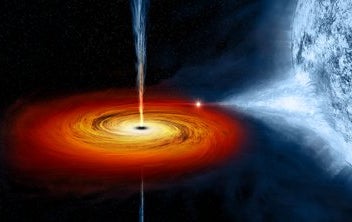X-ray vision sheds light on matter doomed to become a black hole’s meal, scientists say
Scientists are now using a telescope sensitive to polarized X-rays to better understand the structure of materials falling into black holes

A new form of X-ray vision just gave scientists a close look at the structure of matter about to be swallowed up a black hole.
In a new study published Thursday in the journal Science, scientists describe the first observations of an actively feeding black hole by the new Imaging X-Ray Polarimetry Explorer, or IXPE, a joint mission of Nasa and the Italian Space Agency, ASI.
While other space telescopes can observe X-ray light, notably Nasa’s Chandra X-ray Observatory, the IXPE is the first to focus on polarization of X-rays, that is, the direction in which the X-ray waves oscillate.
The direction of oscillation of an X-ray wave can tell astronomers about the material that it may have passed through on its way to observers, and in the case of the black hole known as Cygnus X-1, it allowed researchers to determine the shape and location of material whirling around the black hole like water circling a drain.
“Previous X-ray observations of black holes only measured the arrival direction, arrival time and energy of the X-rays from hot plasma spiraling toward the black holes,” Wayman Crow Professor of Physics at Washington University in St. Louis and lead author of the study Henric Krawczynski said in a statement. The polarization of X-rays, he says, “carries information about how the X-rays were emitted — and if, and where, they scatter off material close to the black hole.”
The gravity of Black holes is so strong that nothing, not even light, can escape them once crossing past a threshold near the black hole known as the event horizon. But an actively feeding black hole — that is, a mass-accreting black hole — will pull surrounding matter into a whirling disk that rushes around the black hole as the matter falls over the lip of the event horizon.
The whirling matter is known as an accretion disk, and the material can become so compressed and superheated that it emits powerful X-rays before falling into the black hole, which IXPE scientists can now detect and study.
The study revealed that from the point of view of Earth, the “accretion flow is seen more edge-on than previously thought,” Astronomical Institute of the Czech Academy of Sciences astrophysicist and study co-author Michal Dovčiak said in a statement.
Cygnus X-1 is the first mass-accreting black hole scientists have studied using the IXPE. It’s a 21-solar mass black hole located 6,070 light years from Earth, and is currently feeding on matter pulled from its companion, a nearby blue giant star.
“These new insights will enable improved X-ray studies of how gravity curves space and time close to black holes,” Dr Krawczynski said.
The IXPE mission goes beyond black holes, and scientists have already studied supernova remnants, neutron stars, pulsars, active galactic nuclei, and just about any phenomena in space generating extreme X-rays.
Join our commenting forum
Join thought-provoking conversations, follow other Independent readers and see their replies
Comments